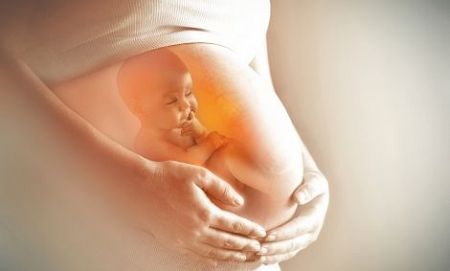Babies in the womb love when their mother talks to them
- Unborn babies appear to show early signs of trying to communicate in the womb
- Babies even appeared to smile slightly more in the womb during bump-stroking
- It could be a very early, hard-wired attempt to communicate with their mother
Pregnant women who stroke and talk to their bumps will be reassured to know that their offspring may be responding to them in the womb.
Unborn babies appear to show early signs of trying to communicate when they hear their mother or feel her touch.
Researchers worked this out by using high-resolution ultrasound footage of babies in the womb, between 25 and 33 weeks of pregnancy.
Those whose mothers had an interactive conversation with them for two minutes opened their mouths much more, which could be a very early, hard-wired attempt to communicate.
And unborn babies whose mums intermittently stroked their bump touched their own face and body far less than when the women spoke.
The scientists suspect they may do this to concentrate on the sensation of touch from their mother.
Babies even appeared to smile slightly more in the womb during bump-stroking, compared to when their mothers were silent and still.
The findings follow evidence that newborn babies are already able to copy their parents’ smiles, frowns and hand gestures, and become upset when someone stops talking to them.
Dr Emese Nagy, lead author of the study from the University of Dundee, said: ‘These results establish what mothers already know – that their babies are communicating with them before they are born. Although this is a small study, it certainly indicates that interacting with an unborn baby is not just wishful thinking on the part of the mother.’
The study, published in the journal Infant Behaviour and Development, recruited 12 pregnant women for ultrasound scans.
The women were asked to try five different types of interaction with their child, including sitting silent and still for two minutes.
They were asked to speak in unnatural five-second bursts to their child, or to talk normally to them and react to their movements.
And they either stroked their bump in five-second bursts or did so normally in response to their child – for example lightly stroking their belly if their baby seemed agitated.
The bursts of speech and touch were ‘non-interactive’ while the women behaving normally was ‘interactive’.
The ultrasound videos showed babies in the womb had their mouths open less than 2% of the time when their mother spoke in unnatural bursts, but, when she spoke normally to them, this rose to almost 5%.
Unborn babies touched their own face and body more than 60% of the time when their mother spoke.
But that fell to a quarter of the time when she touched her belly non-interactively, which suggests they were responding to touch. Their smiles also increased during interactive touch.


